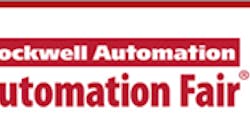The automotive industry has more end-to-end connectivity than any other vertical market. Information moves from suppliers into vehicle design and manufacturing and then on to dealerships, consumer configurations and on-vehicle, real-time diagnostics. That requires a flattened and flexible communication system.
Network architecture requires attention to visibility and security, especially in a global economy. “North American automotive production is a globally connected industry,” said Joe Langley, principal analyst, North American vehicle production forecasting & analytics at IHS Automotive, who provided the framework for discussion during the Automotive Industry Forum held by Rockwell Automation during its Automation Fair event in Chicago.
“We’re moving from global platforms to global super sets, which include vehicles, segments and markets,” said Langley. “Manufacturers are looking at modular sets to plug and play. These create economies of scale.”
Half of North American production will come from these super sets, which is slightly less than the global movement. One potential downside of the super set is that a defective product—for example, a brake pedal—that’s placed in a few million vehicles now creates enormous problems on a global scale if something goes wrong.
Flex automotive muscle
Four years ago, George Jewell was responsible for putting together specifications for assembly systems at General Motors, where he’d worked for 17 years. “At GM, we’d spend six to eight weeks making changes to an assembly line, using six engineers, usually working on third shift,” said Jewell, who’s now vice president at eFlex Systems, a 25-year-old provider of technology for manufacturing and assembly systems.
“Panels are not part of the lines any more. This allows for a plug-and-play environment.” George Jewell, vice president at eFlex Systems, recalls the conversion to flexible assembly systems at GM Powertrain.
“There’s a lot of changing demand out there, from changing products to different customer demands,” said Jewell. “It’s also very difficult to forecast consumer demand and commodity prices for oil or steel. If manufacturing doesn’t have flexibility, then it could mean lost sales.”
Redeployment of resources
Flexible manufacturing and assembly cost more to implement, but there are significant lifecycle cost reductions. “Being able to redeploy resources is very important in this global market,” said Jewell. “And, with a flexible system, we can make changes in minutes, not hours.”
Flexibility also enforces design and process standards. “You’d think that standards limit flexibility, but flexibility allows you to change within those standards,” explained Jewell. “A PLC with no programming is very flexible, for example, but changing it is very labor intensive. A flexible system should enforce standards but support changing standards, too. A flexible system facilitates a continuous-improvement culture by allowing plant-floor people to make those changes and see the effects.”
One of the big challenges for switching to a flexible system is gaining leadership support. “Without that support, it’s impossible to accomplish,” said Jewell. “Even with support, middle management can hinder progress. And there can be barriers between siloed groups. Standards should be systemic, involving many stakeholders. Systemic solutions involve all of the siloed organizations within the company.”
The path to flexibility
At General Motors, Jewell’s first order of business was to gain that support for a flexible assembly system from top leadership. “The cost to implement a flexible system is 10% higher in hardware,” he explained. “We paid $500,000 for the first line. It can be difficult to get upper management to focus on the lifecycle cost, rather than the initial cost.”
Once top leadership is onboard, the champion can come from anywhere, as long as it’s specific to the operation. “It could be from middle management or engineering,” said Jewell. “We had to find leadership in the company that could work with and have authority over all of the different areas of the plant. Then we started with a pilot line.”
Jewell and his team defined equipment standards at the machine level and the operator level first. “It’s important to push that down to the plant floor and talk to them and work those standards from the bottom up,” he explained. “Once standards were developed and leadership support was gained, the solution followed pretty easily. Management, process, controls engineers and suppliers all collaborated on the solution.”
Each station on the flexible assembly lines Jewell helped commission at GM used sealed IP65 and IP67 components, which increased flexibility by eliminating the need for panels. “Panels are not part of the lines anymore,” said Jewell. “This allows for a plug-and-play environment. There’s one set of prints and one program for each station. When I was in the controls area, we had about 30 central controls guys.”
A powertrain standard
The flexible system approach has been in place at General Motors for about a decade now, and it’s in all of the company’s powertrain assembly plants around the world. It supports and enforces GM Powertrain standards, but most importantly it allows for the addition or movement of devices such as torque tools and vision systems. There’s no PLC or HMI programming.
“A configuration and data-gathering software was developed by eFlex, which allowed for configuration of station automation and data gathering. The eFlex configuration system uses task cards that represent tasks in the station, which allows for editing of model parameters.”





